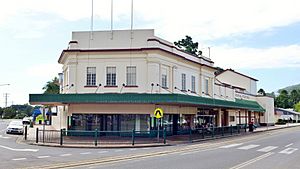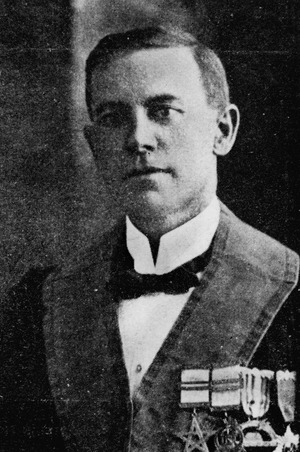Mossman Shire Hall and Douglas Shire Council Chambers facts for kids
Quick facts for kids Mossman Shire Hall and Douglas Shire Council Chambers |
|
|---|---|

Mossman Shire Hall, 2015
|
|
| Location | 8-14 Mill Street, Mossman, Shire of Douglas, Queensland, Australia |
| Design period | 1919 - 1930s (interwar period) |
| Built | 1937 |
| Architect | Hill & Taylor |
| Architectural style(s) | Functionalism |
| Official name: Mossman Shire Hall and Douglas Shire Council Chambers (former) | |
| Type | state heritage (built) |
| Designated | 6 August 2010 |
| Reference no. | 602758 |
| Significant period | interwar period |
| Significant components | shop/s, hall, office/s, stage/sound shell |
| Builders | Tarmey & Euhus |
| Lua error in Module:Location_map at line 420: attempt to index field 'wikibase' (a nil value). | |
The Mossman Shire Hall and Douglas Shire Council Chambers is an old town hall building in Mossman, Australia. It was designed by architects Hill & Taylor and built in 1937. This important building is now listed on the Queensland Heritage Register, which means it's protected because of its history and special design.
Contents
A Look Back: The Hall's History
The Mossman Shire Hall was built between 1936 and 1937. It's a big, important building that shows how much the sugar industry helped North Queensland grow. It also shows how Mossman became a busy town and a main center for local government, while Port Douglas became less important.
How Mossman Became Important
Mossman is a town near the Mossman River, about 70 kilometers north of Cairns. Port Douglas was first set up in 1877 as a port for gold miners. But when a railway was built to Cairns, Port Douglas slowly became less busy.
Meanwhile, the Mossman area started growing sugar cane in the 1890s. The Mossman Central Mill was built in 1894-1895 to process sugar. Even after a big cyclone in 1911 damaged many buildings, Mossman kept growing. Businesses and important services, like the Court House and banks, moved from Port Douglas to Mossman. By the late 1920s, Mossman was the main administrative center for the Douglas Shire area.
Building a New Hall for the Community
Even though Mossman was growing, the local government (Douglas Shire Council) still met in Port Douglas. But in 1932, new rules meant Mossman got more say in the council. In 1933, Raymond David Rex became the Chairman of the council. He wanted to improve Mossman, including getting better water and street lights.
In 1934, Rex suggested building a new shire hall and council offices in Mossman. The council had owned the land since 1903. This project was special because it used money from the Queensland Government's Unemployment Relief Scheme. This scheme helped create jobs during tough economic times in the 1930s. Many public buildings across Queensland were built this way.
Designing and Building the Hall
The council agreed to Rex's idea to build a hall, offices, and even shops to help pay for it. They chose plans from famous Cairns architects, Richard Hill and AJH Taylor. These architects designed many important buildings in North Queensland.
It took a while to agree on the final design. There were some disagreements about the building's style and what it should include. The final plan for the new hall complex included four shops, council offices upstairs, a main hall, a supper lounge, and a stage.
Building the hall also had its challenges. The first builders nominated didn't work out, and the job eventually went to Tarmey & Euhus. Despite some problems during construction, the building was finally finished in 1937 and officially opened on June 9, 1937.
How the Hall Was Used
The new shire hall had four shops on the ground floor, including a chemist and a cafe. Having shops in public buildings was a popular idea in the 1920s and 1930s. It helped bring in money to cover the costs of these large projects.
The Mossman Shire Hall was used for many community events. It had a stage, orchestra pit, and dressing rooms. During World War II, soldiers even used the hall for dances!
In the 1970s, some changes were made to the hall, like enclosing a wall to reduce noise from a nearby tram line. In 1996, the Douglas Shire Council moved to new offices. Today, the former Mossman Shire Hall is still used for community events, and the shops on the ground floor are still in use.
What the Hall Looks Like
The former Mossman Shire Hall and Douglas Shire Council Chambers is a large concrete building in the middle of Mossman. It's located where Mill Street, Junction Road, and the Captain Cook Highway meet. The building has two main parts: a two-story section at the western end with shops and offices, and a larger section to the east with the main hall.
Shops and Offices
The shops on the ground floor are protected by a long awning. The building originally had four shops. Three of them still have their large display windows and recessed doors. The walls around these windows have cool green, red, and black tiles.
Above the awning, the office section has classic-looking details like columns (called pilasters) and decorative borders. There are many steel-framed windows that let in light and air to the offices. The roof over the offices is hidden behind a decorative wall called a parapet, which has three flagpoles.
The Hall Area
Further east, the building steps back from the street. The main hall floor is a bit higher than the street. The hall has a gabled roof and windows high up (clerestory lights) that let in light.
Inside, the hall is mostly original. The ceilings have decorative designs, and the arch around the stage (proscenium arch) has fancy patterns. There are French doors that open to a supper lounge. The stage is about one meter above the hall floor. It has a sloped floor and has been extended. The dressing rooms on either side of the stage are mostly original.
Why It's a Heritage Site
The Mossman Shire Hall and Douglas Shire Council Chambers was added to the Queensland Heritage Register in 2010. This means it's considered very important for a few reasons:
- Showing Queensland's History: The hall shows how public buildings were built in the 1930s, often with government money to create jobs during the Great Depression. It also shows how Mossman grew as a sugar town and became the main center for the Douglas Shire.
- A Great Example of a Civic Building: This building is a good example of a regional civic complex from the 1930s. It still has many of its original features, like the steel-framed windows, the decorative awning, the tiled shop fronts, and the beautiful plasterwork inside. It combines council offices, shops, and a large public hall all in one place.
- Designed by Famous Architects: The hall was designed by Hill and Taylor, who were very important architects in North Queensland during that time. It helps us understand their work and how they shaped the buildings in the region.


